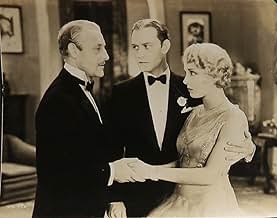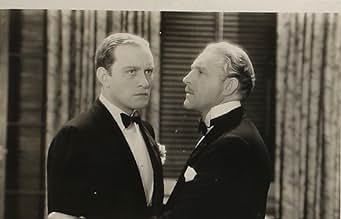Edward Wales stages a seance to catch his friend's murderer. With 13 suspects, one kills again during the seance. The medium investigates when someone close is accused, aiming to expose the ... Read allEdward Wales stages a seance to catch his friend's murderer. With 13 suspects, one kills again during the seance. The medium investigates when someone close is accused, aiming to expose the real culprit.Edward Wales stages a seance to catch his friend's murderer. With 13 suspects, one kills again during the seance. The medium investigates when someone close is accused, aiming to expose the real culprit.
- Director
- Writers
- Stars
- Awards
- 1 win total
Charles Quatermaine
- Dr. Philip Mason
- (as Charles Quartermaine)
- Director
- Writers
- All cast & crew
- Production, box office & more at IMDbPro
Featured reviews
This isn't a typical Tod Browning film. It's more or less a very basic filming of a stage play (I gather; I don't know that for sure, but it feels very stagey) about a group of rich people who hire a medium to find out who killed their friend (and, to some of the group, an enemy). When they go into their seance, right as the name of the killer is about to be spoken, one of the men in the circle, the one who was succeeding at questioning the medium, is stabbed in the back. They then call a detective (Bela Lugosi) who grills them, trying to discover who murdered both of these men. I don't generally like whodunits, especially the Clue variety, where a detective gathers all the suspects in a room and attempts to root out the real killer, but The Thirteenth Chair is exceptionally written. The characters, and there are many, are quite well developed. The climactic scene, while asking that we suspend our disbelief, is truly suspenseful. See this gem if you ever get the chance. 9/10.
Given the numerous bad reviews I didn't expect to enjoy the film as much as I did. If you are an old classic movie fan, you can overlook the poor sound and visual clarity of a 1929 film, especially when the story and cast hold your attention. Leila Hyams and Margaret Wycherley are excellent, as is seeing Bella Lugosi in an earlier film role. For a movie shot in basically in two rooms, I think it was well done. I'm glad I didn't let some of the low ratings deter me from watching, it's nice to be surprised when you come across an old gem.
You have to be a fan of Bela Lugosi to really enjoy this film. The pacing is slow, the direction is wooden, and many of the supporting cast is just so-so.
Being a filmed stage play in the very early talky era, The Thirteenth Chair doesn't have much action. What it does have is Bela Lugosi who becomes the focus of the film as Inspector Delzante as soon as he makes an appearance. There are few surprises to anyone who has seen very many mysteries, but a few genuinely spooky scenes occur in the darkened room as the sound takes over and your imagination is allowed to supply the imagery. On the prints that I have seen the sound is of a poor quality with a high level of hiss as in so many older films. It takes some dedication to sit through, and listening carefully to understand all the dialogue. It is fascinating to see Lugosi as a key supporting character before he was typecast.
Being a filmed stage play in the very early talky era, The Thirteenth Chair doesn't have much action. What it does have is Bela Lugosi who becomes the focus of the film as Inspector Delzante as soon as he makes an appearance. There are few surprises to anyone who has seen very many mysteries, but a few genuinely spooky scenes occur in the darkened room as the sound takes over and your imagination is allowed to supply the imagery. On the prints that I have seen the sound is of a poor quality with a high level of hiss as in so many older films. It takes some dedication to sit through, and listening carefully to understand all the dialogue. It is fascinating to see Lugosi as a key supporting character before he was typecast.
Directed by Tod Browning, The Thirteenth Chair is a well-written and acted murder mystery from a time (1929) when, due to primitive sound recording techniques, the camera had to remain in one place during a scene. The result is that the movie, while well-designed, is rather static visually. It more than makes up for this by having an exciting, if at times rather hard to follow plot, and an ingenious script with enough twists and turns in the plot to satisfy most mystery fans. For claustrophiles the movie is a delight: no one goes ANYWHERE in this film. There are some interesting visual and spatial peculiarities in the movie, such as very high ceilings on the sets, and more obviously fake than usual exteriors just outside the windows. People have a way of assembling in rooms rather than just sitting there or milling around, which gives the movie an offbeat, ritualistic feeling; probably typical enough in the theater of the time, but unusual in a film.
The actors, notably Margaret Wycherly, are quite good, with Bela Lugosi giving an energetic reading of a shrewd police detective in a quite different key from his later work. One can't help but wonder what sort of screen actor Lugosi might have become had he not been typecast in horror roles. Leila Hyams is radiant as one of the chief suspects, and it's remarkable that she didn't become a bigger star, on looks alone. There is no pace to speak of in the film, as the story proceeds by dialog, and by people entering and exiting rooms on cue. Nor are there any of the typical Browning flourishes, as the movie seems anonymously directed. But the script is very tight, and there are some surprises along the way, and moments of unexpected warmth and feeling that make this a watchable and satisfying antique.
The actors, notably Margaret Wycherly, are quite good, with Bela Lugosi giving an energetic reading of a shrewd police detective in a quite different key from his later work. One can't help but wonder what sort of screen actor Lugosi might have become had he not been typecast in horror roles. Leila Hyams is radiant as one of the chief suspects, and it's remarkable that she didn't become a bigger star, on looks alone. There is no pace to speak of in the film, as the story proceeds by dialog, and by people entering and exiting rooms on cue. Nor are there any of the typical Browning flourishes, as the movie seems anonymously directed. But the script is very tight, and there are some surprises along the way, and moments of unexpected warmth and feeling that make this a watchable and satisfying antique.
In British India, a séance in Calcutta leaves a dead man sitting in THE THIRTEENTH CHAIR...
Under the able direction of Tod Browning, this antique talkie weaves a taut tale of murder & suspense. The oppressive atmosphere & limited use of sets creates a claustrophobic sense of eerie unreality. The excellent utilization of sound during the sequences of almost total screen blackout demonstrate the director's understanding of the potentialities of the new medium.
Conrad Nagel & Leila Hyams receive top billing, but they have little to do beyond looking frightened or concerned. This they accomplish quite well.
The film is dominated by two fascinating performances. Bela Lugosi makes a rather bizarre police inspector, his mesmeric eyes, claw-like hands & compelling voice giving an early demonstration of the qualities which would make him one of the screen's top monsters (Lugosi & Browning would have to wait two more years for the huge success of their next collaboration, DRACULA). Elderly Margaret Wycherly, as a wily Irish medium, is a delight and easily steals scene after scene. It is she who comes up with the plan to ultimately unmask the killer.
Under the able direction of Tod Browning, this antique talkie weaves a taut tale of murder & suspense. The oppressive atmosphere & limited use of sets creates a claustrophobic sense of eerie unreality. The excellent utilization of sound during the sequences of almost total screen blackout demonstrate the director's understanding of the potentialities of the new medium.
Conrad Nagel & Leila Hyams receive top billing, but they have little to do beyond looking frightened or concerned. This they accomplish quite well.
The film is dominated by two fascinating performances. Bela Lugosi makes a rather bizarre police inspector, his mesmeric eyes, claw-like hands & compelling voice giving an early demonstration of the qualities which would make him one of the screen's top monsters (Lugosi & Browning would have to wait two more years for the huge success of their next collaboration, DRACULA). Elderly Margaret Wycherly, as a wily Irish medium, is a delight and easily steals scene after scene. It is she who comes up with the plan to ultimately unmask the killer.
Did you know
- TriviaCompleted July 16 1929, the first sound feature in which Bela Lugosi's famous Hungarian tones were heard. This was Bela Lugosi's first venture with Browning. Two years later, the director cast him in the film version of the Bram Stoker vampire tale after Chaney, Browning's first choice for the role, died. Lugosi and Browning made one other film together, Mark of the Vampire (1935), in which he played Count Mora, a knock-off of his more famous blood-sucking cousin.
- GoofsThere are several scenes where it appears the actors are waiting for their cues before they start talking, most notably when the Inspector calls them all into the room to re-create the séance.
It isn't a "goof" that the actors seem to be waiting for their cues before they start acting. Many of the earliest MGM talkies employed a technique of long, lingering inactive moments at the beginning and ending of reels, which apparently were supposed to take the place of a leader when they changed over, perhaps accommodating the Vitaphone print versions. Years ago, when these titles appeared on TV, they didn't do that, so maybe Movietone versions were more succinctly edited.
- Quotes
Inspector Delzante: [Interrogating Madame La Grange, consulting his notes] Perhaps this will refresh your memory.
- Alternate versionsMGM also released this movie in a silent version at 1628.55 m in length. The silent version of the film is considered lost as of February 2021.
- ConnectionsReferenced in You Must Remember This: Bela and the Vampires (Bela & Boris Part 2) (2017)
Details
- Release date
- Country of origin
- Language
- Also known as
- The 13th Chair
- Filming locations
- Production company
- See more company credits at IMDbPro
- Runtime
- 1h 12m(72 min)
- Color
- Aspect ratio
- 1.20 : 1
Contribute to this page
Suggest an edit or add missing content






























